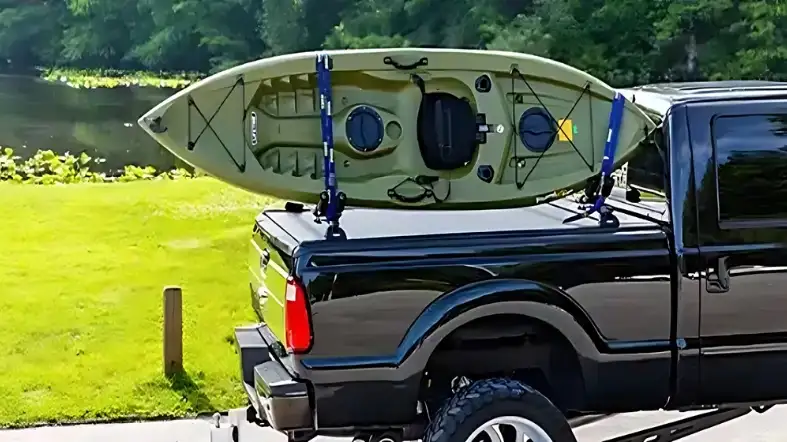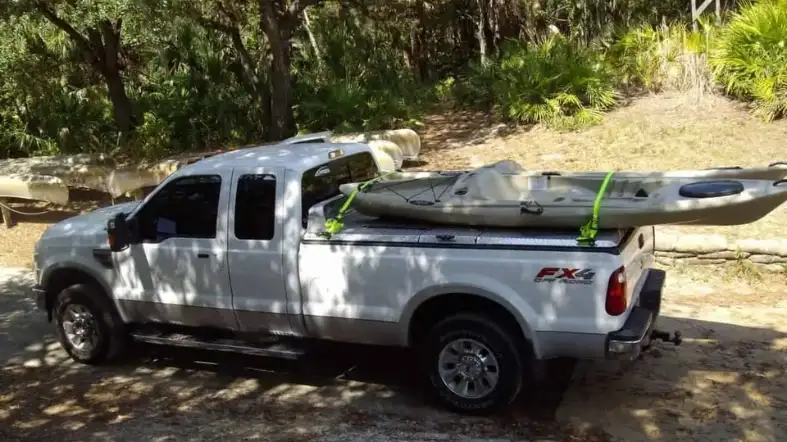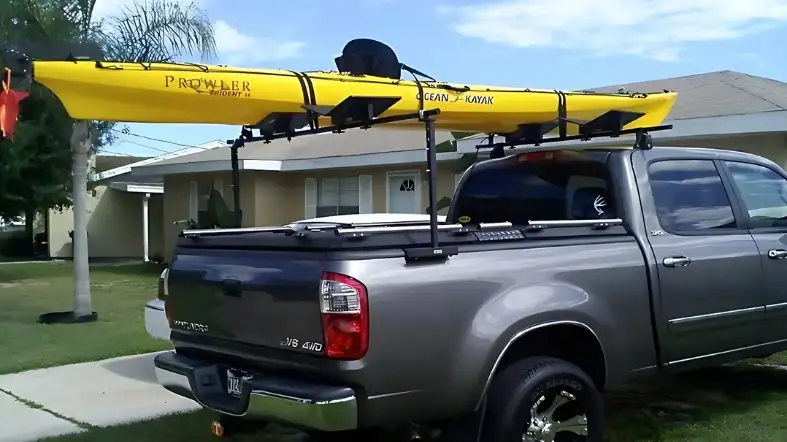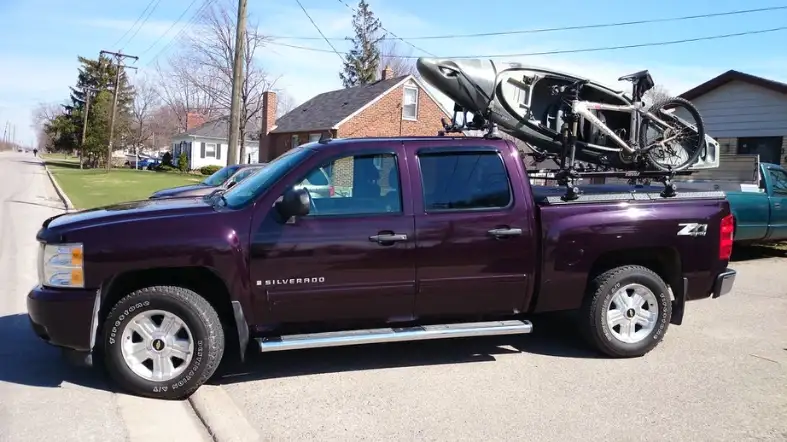Are you an avid kayaker looking to take your adventures on the road?
If you own a truck with a tonneau cover, you might be wondering how to transport your kayak safely and securely. Fret not!
In this guide, we’ll show you expert tips and tricks for hauling a kayak on a truck with a tonneau cover.
Say goodbye to worries about damage or wind resistance during transportation. Get ready to hit the road with your kayak and embark on unforgettable water escapades!

How do you haul a kayak on a truck with a tonneau cover?
Securing your kayak on a truck with a tonneau cover might seem like a daunting task. But with the right techniques, you can transport your kayak in no time!
Here’s a step-by-step guide on how to haul a kayak on a truck with a tonneau cover:
Choose the Right Tonneau Cover
Select a tonneau cover that is compatible with kayak transportation.
Look for options like roll-up, folding, or retractable covers that provide easy access to the truck bed while ensuring sufficient protection for your kayak.
Measure and Prepare
Measure the dimensions of your kayak and the truck bed to ensure a proper fit. Remove any accessories or loose items from the truck bed and clean it.
This will create a clean and safe environment for securing your kayak.
Install the Tonneau Cover
Follow the manufacturer’s instructions to install the Tonneau cover on your truck. Ensure that it is aligned and locked in place.
A well-installed cover will provide a sturdy foundation for hauling your kayak.
Use Kayak Racks or J-Hooks
To secure your kayak, consider using kayak racks or J-hooks designed for truck bed transportation.
These accessories provide stability and prevent the kayak from shifting during transit.
Position the Kayak
Place the kayak in the truck bed, aligning it parallel to the truck’s length. Make sure it is centered and positioned to distribute the weight.
Adjust the kayak’s position as necessary to ensure a balanced load.
Secure the Kayak
Attach straps or bungee cords to the kayak and anchor points in the truck bed. Start by securing the bow (front) of the kayak, then move to the stern (rear).
Tighten the straps to hold the kayak in place, but avoid over-tightening, as it may damage the tonneau cover or the kayak itself.
Double-Check for Security
Before hitting the road, give the kayak and straps a final check to ensure everything is secure.
Shake the kayak to ensure it doesn’t move excessively. Confirm that all straps are fastened and secured to prevent any potential mishaps during transportation.
Test Drive
Take a short test drive to assess the stability of the kayak and the tonneau cover. Pay attention to any signs of shifting or movement.
If necessary, stop and readjust the straps to ensure a secure fit.
By following these steps, you can confidently haul your kayak on a truck with a tonneau cover.
Understanding Tonneau Covers and their Benefits

With numerous options available in the market, it can be perplexing to determine which one will suit your needs the best.
Here, we will discuss how to select the perfect tonneau cover for hassle-free kayak transportation.
Step 1: Assess your Transportation Requirements
To begin your search for the ideal tonneau cover, you need to evaluate your specific kayak transportation requirements.
Consider the size and weight of your kayak, as well as the frequency of your trips.
Step 2: Explore Tonneau Cover Types
Next, familiarize yourself with the various types of tonneau covers available in the market. Here are a few popular options:
a) Roll-Up Tonneau Covers
These covers are made of durable materials and can be rolled up to access the truck bed.
They provide excellent protection against the elements and can accommodate kayaks of various sizes.
b) Folding Tonneau Covers
Folding covers offer a convenient way to access your truck bed. They consist of multiple panels that can be folded up, allowing easy loading and unloading of your kayak.
These covers are sturdy and provide adequate protection for your cargo.
c) Retractable Tonneau Covers
Retractable covers offer the utmost convenience and security. With the push of a button, the cover retracts into a housing unit, providing full access to your truck bed.
These covers are durable and weather-resistant, ensuring your kayak remains safe during transportation.
Step 3: Consider Security Features
The security of your kayak is paramount during transportation. Look for tonneau covers that come with robust locking systems to secure your trifold tonneau cover and prevent unauthorized access to your truck bed.
Some covers offer integrated locks, while others are compatible with aftermarket security devices.
Consider covers with weather seals to keep your kayak protected from rain, dust, and debris.
Step 4: Assess Installation and Compatibility
Before making a final decision, it’s essential to ensure that the tonneau covers you choose are compatible with your truck model.
Check the specifications provided by the manufacturer to confirm the fit.
Consider the installation process. Choose one that aligns with your preferences and capabilities.
Step 5: Read Customer Reviews and Ratings
To gain further insight into the performance and durability of a tonneau cover, take the time to read customer reviews and ratings.
Online platforms and forums can provide valuable information from individuals who have already used the product.
Pay attention to both positive and negative feedback to make an informed decision.
Step 6: Set a Budget
Last but not least, establish a budget for your tonneau cover purchase. Prices can vary depending on the type and brand of the cover.
Consider your financial constraints and prioritize features that are essential for your kayak transportation needs.
Remember that investing in a high-quality tonneau cover will offer long-term benefits and protect your kayak effectively.
By following these steps, you’ll be well-equipped to select the perfect tonneau cover for your kayak transportation needs.
Important Factors to Consider for Safe Kayak Hauling

To have a secure and worry-free experience, there are several factors you need to consider.
By paying attention to these crucial aspects, you can ensure the safe transportation of your kayak.
Assess Your Vehicle’s Weight Capacity
Before you start hauling your kayak, it’s essential to determine your vehicle’s weight capacity.
Consult your vehicle’s manual or contact the manufacturer to find the maximum weight limit for your specific model.
Ensure that the combined weight of your kayak, kayak accessories, and any additional equipment does not exceed this limit.
Overloading your vehicle can negatively impact its performance and safety.
Invest in High-Quality Roof Racks
To transport your kayak, invest in high-quality roof racks that are compatible with your vehicle.
Roof racks provide a stable platform for your kayak and help distribute the weight evenly.
Look for frames that have adjustable padding or cradles designed for kayaks to prevent scratches or damage.
Ensure that the racks are installed and securely attached to your vehicle.
Properly Secure the Kayak
To prevent the kayak from shifting or falling during transportation, it’s crucial to secure it.
Start by placing the kayak on the roof racks, and aligning it with the vehicle’s centerline. Use solid and reliable tie-down straps or ropes to secure the kayak to the roof racks.
Fasten the straps, ensuring there is minimal movement. It’s recommended to use at least two straps, attaching them at multiple points to increase stability.
Regularly check the straps during the journey to ensure they remain tight and secure.
Consider Wind Resistance
When hauling a kayak, wind resistance can be a significant factor to consider.
The added bulk and height of the kayak on your vehicle can increase wind resistance, affecting your vehicle’s stability and fuel efficiency.
To minimize wind resistance, consider using a kayak cover or wrap to streamline the shape.
Additionally, drive at a moderate speed and avoid sudden maneuvers to maintain control and reduce the impact of wind.
Check Height Clearance
Before setting off, make sure to check the height clearance of your vehicle with the kayak loaded on the roof.
Measure the overall height of your vehicle, including the kayak and roof racks.
Compare this measurement with any potential clearance obstacles, such as low bridges or parking structures, along your planned route.
It’s crucial to avoid situations where the kayak might come into contact with overhead structures.
Regularly Inspect and Maintain Equipment
To ensure ongoing safety during kayak hauling, regularly inspect and maintain your equipment.
Check the condition of the roof racks, tie-down straps, and kayak accessories before each trip.
Look for signs of wear, rust, or damage that may compromise their effectiveness.
Replace any worn-out or damaged components promptly to avoid potential failures during transportation.
By considering these important factors, you can ensure the safe and secure hauling of your kayak.
Maintaining the Tonneau Cover and Protecting the Kayak

Proper maintenance of your tonneau cover and ensuring the protection of your kayak are essential for long-term use and preserving the condition of both.
By following these steps, you can effectively maintain your tonneau cover and keep your kayak in excellent shape.
Regular Cleaning and Inspection
To maintain your tonneau cover, it’s important to clean it regularly. Use a mild soap or specialized tonneau cover cleaner, along with a soft brush or cloth, to remove dirt, grime, and debris.
Avoid using harsh chemicals or abrasive materials that could damage the cover’s surface. After cleaning, rinse thoroughly with water and allow it to air dry.
While cleaning, take the opportunity to inspect the tonneau cover for any signs of wear, tears, or loose components.
Check the latches, hinges, and seals to ensure they function properly. Address any issues promptly to prevent further damage and maintain the cover’s integrity.
Lubricate Moving Parts
To keep the moving parts of your tonneau cover in good working condition, it’s important to lubricate them regularly.
Apply a silicone-based lubricant to the hinges, latches, and any other movable components.
This will help reduce friction, prevent rust, and ensure smooth operation. Follow the manufacturer’s recommendations for the appropriate lubricant to use.
Protect Against UV Exposure
UV rays can cause damage and fade to both your tonneau cover and kayak over time. To protect against UV exposure, consider using a UV protectant spray or dressing.
Apply the protectant to the tonneau cover as well as any plastic or rubber components.
This will help prevent fading, cracking, and premature aging caused by the sun’s harmful rays.
Secure the Kayak Properly
When loading your kayak onto the truck bed, it’s important to secure it properly to prevent damage during transportation.
Use padding or foam blocks to provide cushioning between the kayak and the tonneau cover or other surfaces. This will help prevent scratches and dents.
Use high-quality straps or tie-downs to secure the kayak tightly to the anchor points on the truck bed.
Ensure the straps are fastened securely and provide sufficient tension to keep the kayak in place.
Regularly check the straps during transportation to ensure they remain tight and secure.
Use Protective Accessories
To provide additional protection for your kayak, consider using accessories such as kayak covers or cockpit covers.
These accessories can help shield your kayak from dirt, debris, and UV rays during transportation and storage.
They can also help prevent water from pooling inside the kayak, which could lead to damage or mildew.
Store the Kayak Properly
When not in use, store your kayak in a safe and appropriate location. Ideally, it should be stored in a dry and protected area, away from direct sunlight and extreme temperatures.
Store the kayak indoors or use a kayak storage rack designed for safe and secure storage.
FAQs
What Type Of Tonneau Cover Is Best For Hauling A Kayak?
Roll-up, folding, or retractable tonneau covers are all suitable for hauling a kayak.
Choose one that meets your needs for accessibility and protection.
Can I Open The Tonneau Cover With The Kayak Loaded?
It depends on the type of tonneau cover you have.
Roll-up and folding covers can be opened partially or fully to access the truck bed, while retractable covers provide full access.
How Do I Protect My Kayak From Scratches?
To protect your kayak from scratches, use foam blocks or padding between the kayak and the tonneau cover or other surfaces.
This will provide cushioning during transportation.
Can I Use A Tonneau Cover With A Roof Rack For Additional Kayak Storage?
Yes, you can use a tonneau cover in combination with a roof rack to transport multiple kayaks or other gear on the roof of your truck.
Are There Any Height Restrictions For Hauling A Kayak With A Tonneau Cover?
It’s important to consider height clearance when hauling a kayak with a tonneau cover.
Measure the overall height of your vehicle with the kayak loaded to ensure it fits under any potential clearance obstacles.
Final Words
Effortlessly transport your kayak on a truck with a tonneau cover by following these guidelines.
Secure your kayak tightly using high-quality tie-downs and consider foam padding for added protection.
Choose a tonneau cover that suits your needs for accessibility and protection.
With proper planning and precautions, you can enjoy hassle-free kayak-hauling adventures while keeping your kayak and truck safe and secure on the road.
